Category:
General News
Richmond, Day 3
Notice: Use of undefined constant the_post_thumbnail - assumed 'the_post_thumbnail' in /home/netscrib/public_html/civilwarcavalry/wp-content/themes/wittenberg/archive.php on line 65

I’ve now been here for 48 hours. It’s been quite eventful.
Yesterday, I had a busload of 60 people that I took around the battlefield at Trevilians. It was a good day and a good group. We covered the entire field, with a particular focus on Custer and his role in the battle. We also had an excellent presentation by the Trevilian Station Battlefield Foundation folks. It as 95 degrees and about 90% humidity, so it was pretty beastly out there. By the time we got done at the first stop, I was drenched in sweat. Fortunately, the night was free. I had dinner and got to relax.
Today was an incredibly busy day. Today was a lecture day. There were talks for most of the day, with me as the closer. There are about 160 attending here–yesterday’s tour was an optional pre-conference tour–so they had me talk about Trevilians. I was genuinely surprised to see a lot of the people who attended the tour at the talk. I guess they hadn’t had enough.
Frankly, most of the talks weren’t of much interest to me, so I went off on my own. My first stop was Hollywood Cemetery. I got to see pretty much all of the cool graves (although I couldn’t find Henry Heth’s), and photographed most of them (although I got the rope for the camera in front of the lens while shooting Archer’s grave). I will post most of them when I get home.
I left there and went to the visitor center at the Tredegar Works, and visited the bookstore. From there, I went to the west side of town where Dahlgren and his raiders were repulsed by Confederate home guards. It’s at the intersection of the Three-Chopt Road and Cary Street in the high-rent district of Richmond (most of the battlefield is part of the Country Club of Virginia today).
I then did my talk, sold some books, and then this evening, there was a reception at the Museum of the Confederacy and White House of the Confederacy. Of course, the air conditioning at the MoC went out this afternoon and it was 95 here again today, so it was just ghastly in there.
The highlight was finally getting to meet JEB Stuart, IV. I’d spoken to him on the phone and corresponded with him at length via e-mail, but I’d never met him. Jeb was there to help raise money for the MoC (which is in dire straits financially, by the way), so it was really a pleasure to meet him. Put a bushy beard on him and he would look just like his famous ancestor. I’m going to try to get together with him to show him Trevilians in October–he’s never been there.
Jeb IV spent 27 years in the Army and retired as a colonel. He’s now a stockbroker. Jeb V is an orthopedic surgeon who spent 12 years as an Army doctor. Jeb VI is 15 years old. What a great legacy.
Tomorrow, I have another all-day bus tour. I’ve got one bus and Bobby Krick has the other. Stops include Hanovertown Ferry, Haw’s Shop, Yellow Tavern, Cold Harbor, and a couple of other places. It’s going to be another beastly hot day.
I hope to post more tomorrow night
Scridb filterRichmond, Day 1
Notice: Use of undefined constant the_post_thumbnail - assumed 'the_post_thumbnail' in /home/netscrib/public_html/civilwarcavalry/wp-content/themes/wittenberg/archive.php on line 65

Last week, I visited the final resting place of Ulric Dahlgren. Today, I visited the place where he was killed and where his body was temporarily buried for a day or two. And it cost me $85.00. I’ll explain.
First, greetings from Richmond. I’m writing from the beautiful Omni Hotel, which is at the corner of 12th and Canal Streets. It’s gorgeous, and very plush. The LBHA knows how to do this right.
I spent nearly 8 hours driving to get here. I had planned the trip so that I would have time to drive the thirty or so miles to the spot where Dahlgren fell, which is in King and Queen County, near Walkerton, northeast of Richmond. All worked out well. I got to Dahlgrens Corner, as the place is known today, about 5:30, shot my photos, walked around a bit to get the lay of the land, and then started heading back to Richmond. I will post the photos when I get home to Ohio.
I was talking to Susan on the cell phone while driving. I came to a very sharp curve and, because I had to steer with one hand, drifted out beyond the center line, and damned near ran a Virginia state trooper off the road. I looked in the rear view mirror, saw him swerve, and then just pulled over and sat and waited for him, because I knew he’d be coming. Sure enough, I see the lights come up behind me. When he got to the car, I already had the window open. I didn’t even let him get the “Do you know why I stopped you?” out and instead said, “I guess I went left of center, huh?” He said yes, that I had nearly run him off the road. I apologized, accepted responsibility, and then waited. He looked at my license and registration, and decided that since I’d been honest and forthright, he’d cut me a little slack and only cite me for going left of center and not reckless operation. Hence, the $85, which is how much the fine is.
He asked me what I was doing there–I guess they don’t see many Ohio license plates around those parts–and he told me that his house is right there at Dahlgrens Corner. I proceeded to tell him the story about why that spot was significant, and he really got into it. We shook hands, he told me that the next time I come visit, to visit him and not run him off the road. We both laughed and that was that.
There really was no doubt about it. I DID almost run him off the road, and he had every right to be pissed about it. Since I didn’t give him attitude or blow him any shit, he gave me a break. The lesson is, always tell these guys the truth. They can tell when you’re bullshitting them, and they will be much easier to deal with if they think you’re being a straight shooter with them. They’re just doing their jobs.
So, I got to visit the spot where Ully died, and I will get to pay $85.00 for the privilege. Ah, well. Such is life.
I have a busload of 60 to take to Trevilians tomorrow. Should be a good day.
Scridb filterOn the Road Again…..I Just Can’t Wait to be on the Road Again….
Notice: Use of undefined constant the_post_thumbnail - assumed 'the_post_thumbnail' in /home/netscrib/public_html/civilwarcavalry/wp-content/themes/wittenberg/archive.php on line 65

The Little Big Horn Associates is an organization devoted to….you guessed it, the events of June 25, 1876. There are a lot of scholars whom I respect a great deal who are involved with this organization. Brian Pohanka was a stalwart. Greg Urwin is a regular contributor. I could go on, but you get the idea.
This year’s annual conference is devoted to George A. Custer in 1864, and is based in Richmond. I am pretty much the star of the show. I’m leading a busload tour of Trevilian Station on Wednesday, I’m giving a talk on Thursday, I’m co-leading an all-day battlefield tour with Bobby Krick on Friday, and then I’m participating in a panel discussion on Saturday. My bestest pal, Tom Carhart, is on the program, which should be interesting.
Tomorrow, on my way to Richmond, I’m going to detour to King and Queen County, VA to visit an obscure spot called Dahlgren’s Corner, which is where Ulric Dahlgren was killed. On Thursday morning, I’m going to find the spot where Dahlgren was repulsed from the defenses of Richmond, and then on Thursday afternoon, I will be making my visit to Hollywood Cemetery.
Saturday, after the panel discussion, I drive to Chambersburg to participate in a late-night panel discussion, and then to give a talk on Sunday morning at one of Ted Alexander’s Chambersburg Chamber of Commerce events. I enjoy Ted’s programs and try never to say no when he asks me to come.
So, I’ll be hitting the hot and dusty tomorrow for Civil War Central. I will try to report from the road.
Scridb filterBig Changes Coming….
Notice: Use of undefined constant the_post_thumbnail - assumed 'the_post_thumbnail' in /home/netscrib/public_html/civilwarcavalry/wp-content/themes/wittenberg/archive.php on line 65

I’ve got a major announcement to make. While it impacts my professional life, it will also impact my blogging, which is why I decided to pass this along.
Since October 2002, I’ve been a partner in a small law firm. It hasn’t provided me with the mechanism to really expand my practice that I’d hoped, and I’d been hoping for a better opportunity to come along for some time.
Several weeks ago, that opportunity finally presented itself. Effective August 1, I will be joining a newly-formed law firm as a partner. It was too good an opportunity for me to pass up, and I jumped at it. I am being brought in to head the firm’s litigation practice and it’s going to provide me with the long-missing springboard to take my professional life to the next level. For the first time in years, I feel energized and enthusiastic about the practice of law. I can’t remember the last time that I felt this way.
So, it’s a huge change–trading in an old and comfortable relationship for a bold, new venture. I’m nervous and excited all at the same time. It’s certainly going to be a significant adjustment. I tell all of you this because it will undoubtedly affect my blogging–I don’t know how much, but I’m going to have more on my plate for at least a while during this transition.
I will keep everyone posted as to how things progress. I spent the day today beginning the process of packing up my office and all of my things, never a small task.
Wish me luck. It’s going to be a big change.
Scridb filterLaurel Hill Cemetery, Philadelphia
Notice: Use of undefined constant the_post_thumbnail - assumed 'the_post_thumbnail' in /home/netscrib/public_html/civilwarcavalry/wp-content/themes/wittenberg/archive.php on line 65

As I said on Monday night, Philadelphia’s Laurel Hill Cemetery is a classic example of Victorian cemetery in the French mode. I took a fair number of photographs while I was there, and I want to share some of them with you.
One note of explanation is required. It was 102 degrees with 90% humidity that day, and it was just beastly hot. Within seconds of getting out of the car, I was drenched with sweat, and it was just too hot to do the sort of walking around and searching that I would normally do. Consequently, there were a couple of graves that I had hoped to visit (and photograph) but couldn’t find because it was too damned hot and also because I ran out of time–I had a nearly ninety mile drive to make before my talk that night. Two of the graves I’d hoped to visit but missed were John C. Pemberton, the Philadelphia resident who commanded (and surrendered) the Confederate army at Vicksburg, and Col. Richard Rush, the original commander of the 6th Pennsylvania Cavalry, also known as Rush’s Lancers. While wandering around searching for the Dahlgren graves, I did find the grave of the parents of Maj. Gen. George B. McClellan, and shot a photo of them for Dimitri Rotov.

This is the grave of Revolutionary War hero Maj. Gen. Hugh Mercer, who was killed in action at Princeton, January 2, 1777.
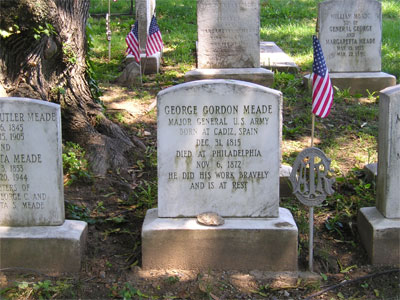
This is the grave of Maj. Gen. George Gordon Meade, who commanded the Army of the Potomac from June 28, 1863 until the end of the Civil War.
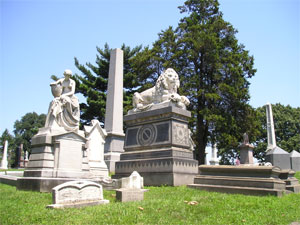
The impressive marker with the lion is that of Maj. Gen. Robert Patterson, who ineffectively campaigned against Stonewall Jackson in the Shenandoah Valley in 1861.
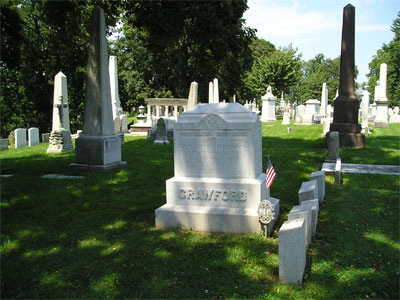
This is the grave of Bvt. Maj. Gen. Samuel W. Crawford, who went from garrison doctor at Fort Sumter to effective division commander in the Fifth Corps.
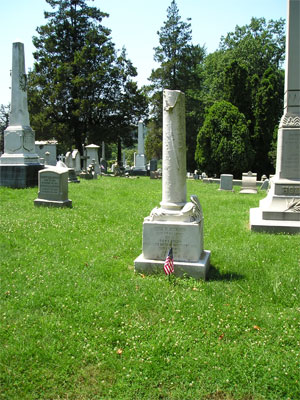
This is the grave of Lt. Benjamin “Benny” Hodgson, who was killed during the valley fight at the Battle of the Little Big Horn, June 25, 1876. The word “cavalry” is misspelled on the marker as “calvery”.
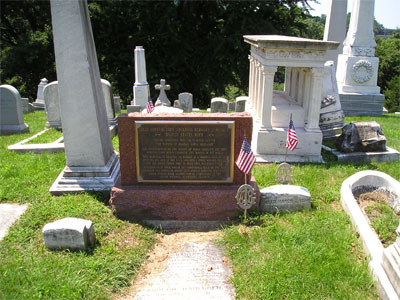
These are the graves of Rear Admiral John A. Dahlgren (on the left, with the very large marker) and his son, Col. Ulric Dahlgren (the small marker on the right).
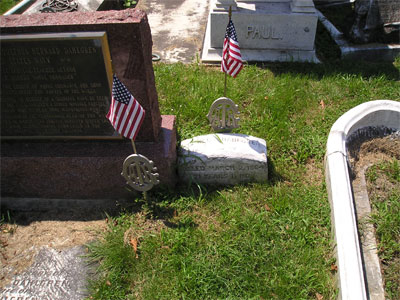
There is also a detail of Ulric’s marker.
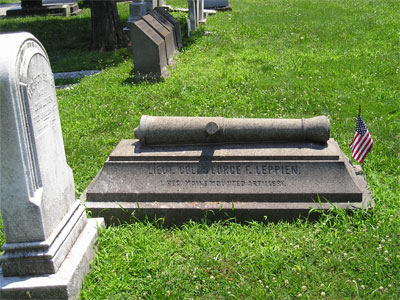
This is the grave of Col. George Leppien, the Pennsylvania artillerist who was killed in action in 1864. Note the rendition of a Napoleon gun on the grave.
I wish I’d had more time and it wasn’t so beastly hot.
Scridb filterInteresting Things Happen When I Travel
Notice: Use of undefined constant the_post_thumbnail - assumed 'the_post_thumbnail' in /home/netscrib/public_html/civilwarcavalry/wp-content/themes/wittenberg/archive.php on line 65

I’m writing this from a Fairfield Inn in Dover, Delaware. I’m here because I spoke to the Central Delaware Civil War Roundtable tonight. It was quite an interesting evening.
A couple of weeks ago, I was asked for a photo, as the CWRT apparently placed something in the local newspaper, which ran the photo with the piece. One of my high school classmates–whom I haven’t seen in nearly twenty years, but who lives and works here, spotted it. She had another obligation tonight and couldn’t come hear me talk, but she wrote me a nice note and left it at the meeting place for me. I was taken aback when I was told that there was a note for me there, and it really kind of blew me away that she took the time to do that. What a pleasant surprise!
Then, after my talk, I got an even bigger surprise. One of the members of the group came up to me after the talk and asked whether I would recognize the name if he told me that his great-great grandparents had been married by S. L. Gracey. That got my attention. Samuel L. Gracey was the regimental chaplain of the 6th Pennsylvania Cavalry, and he wrote the 1868 regimental history of the unit.
The fellow’s ancestor was a member of Co. A of the Lancers, and was married by Chaplain Gracey after the war. The fellow then pulled out a photo. It was a photo of the annual reunion of the veterans of the regiment–usually conducted at Gettysburg–from September 29, 1912, taken in front of the rocks at Devil’s Den. There were only a couple of dozen of them left 49 years after the battle, and it was really a spectactular photograph. He shared his ancestor’s story with me, and then really blew me away–he offered to scan the reunion photo and gave me permission to include it in the new regimental history.
Needless to say, that made my night.
It never ceases to amaze me when I think of the generosity of the people that I’ve met over the years in doing this work. So many neat things have been given to me by folks and this is yet another example of that. I understand why the academics among us resist the idea of speaking to CWRT’s for free, but finds like this make it worthwhile for me. I’m so glad I came here, even if it does mean getting up at 5:15 tomorrow morning to make my flight home…. 🙂
Scridb filterVictorian Cemeteries
Notice: Use of undefined constant the_post_thumbnail - assumed 'the_post_thumbnail' in /home/netscrib/public_html/civilwarcavalry/wp-content/themes/wittenberg/archive.php on line 65

I visited Ully Dahlgren’s grave in Philadelphia’s Laurel Hill Cemetery today. I was struck by just how small the marker on his grave is, particularly as compared to the huge marker for his father that’s quite literally next to Ully’s grave.
Laurel Hill was THE cemetery for Victorian-era Philadelphians. It was designed to be like a park, overlooking the Schuylkill River, and is very different from modern cemeteries. Although it was 100+ degrees out while I was at Laurel Hill, I still did a little bit of wandering around and shot photos of some of the graves of some of the famous folks buried there, but I got to only a small portion of them. It was too hot, I had too little time, and I also was having difficulty finding graves. Tomorrow, once I’ve had a chance to download the digital camera, I will post a few of the notable graves here.
Laurel Hill is one of several cemeteries of its ilk I have visited. I’ve spent time in the city cemetery in Lexington, KY, and in Spring Hill Cemetery in Cincinnati, which is even more park-like than Laurel Hill. There’s also Charles Evans Cemetery in my home town of Reading, PA, which is the final resting place for several Civil War generals, including Bvt. Maj. Gen. David M. Gregg, Brig. Gen. Daniel Keim, and Brig. Gen. Alexander Schimmelfennig, who lies under a nifty marker that’s topped by a marble pickelhaube, and which is marked in German. Hollywood Cemetery in Richmond is another of this variety, but I have yet to visit Hollywood (that, however, will change next week).
These cemeteries are pretty remarkable places. Unlike the memorial park near my house, which is not conducive to folks visiting, these cemeteries were designed to be treated like parks. In fact, Victorians thought nothing of having picnics and outings there. It was sort of like having a picnic in the park, only with lots of dead folks there. To our modern mentality, it seems kind of creepy, and I can certainly understand that. However, Victorians had a different take on death, and they really didn’t give it a second thought.
The other thing that strikes me when I visit these cemeteries is the complexity and beauty of the monuments. There are so many tall obelisks in Laurel Hill that it seems like needles reaching for the sky at times. There are also some amazing examples of sculpture atop some of the graves–I saw one today that was a bronze sculpture of the occupant of the graves seated in a chair, obviously lost in deep thought. The cost of such monuments today would be so astronomical as to be completely offputting. The Victorians, however, thought absolutely nothing of it, which is why you see some of the remarkable structures you see in these Victorian cemeteries.
I also was amazed at the number of fancy mausoleums that fill the center part of Laurel Hill. Some of these structures are incredibly ornate–my wife calls them high rise condos of death, and it’s really not that far from being an accurate description.
As I said, I hope to post some photos of some of the notable graves tomorrow night. Stay tuned.
Scridb filterPeer Review
Notice: Use of undefined constant the_post_thumbnail - assumed 'the_post_thumbnail' in /home/netscrib/public_html/civilwarcavalry/wp-content/themes/wittenberg/archive.php on line 65

Kevin Levin has an interesting post on his blog today expressing his preference for university press books since they utilize an anonymous peer review process. He asked what some of the smaller independents such as Ironclad Publishing, Savas-Beatie, and White Mane do in the way of peer review.
Let me begin by saying that White Mane does none. As it is not much more than a subsidy press, they will publish anything that comes in the door, usually without even copy editing the books. That’s why White Mane has such an atrocious reputation. I might add that the company’s atrocious reputation is richly deserved.
I also want to address the question of university press peer review. I’ve had four books published by university presses, so I have some experience with the process. For the most part, that was a good experience. Most of the feedback that I got was useful, corrected factual errors, and generally made the books better. However, some of it was completely useless to me. The stuff that I’ve had published by university presses has been editing someone else’s words, and my object has always been to remain as faithful as possible to those words. Suggestions like adding discussion about impact on civilians, slaves, etc., are totally useless to me for a variety of reasons.
First, and foremost, the so-called “new military history” holds little interest for me. As a general statement, I couldn’t care less about the impact on civilians, slaves, etc., unless that impact affected the outcome of the battle. Not being an academic historian, I don’t have to bow at the feet of that particular golden calf, and I decline to do so. As a general statement, social history holds very, very little interest for me, so I choose not to deal with it unless it really is important to what I’m doing. To some extent, I have to deal with some of this in my Dahlgren bio, so to the extent that it’s necessary to tell the story, I am doing so. But, that’s the exception and not the rule.
Second, the other issue with academic peer review is that it perpetuates a tendency toward continuing to churn out books that are of little interest to anyone other than those with a heavy academic bent. It’s groupthink. If the manuscript doesn’t fit the template for the “new military history” (whatever that is), then it will be rejected. Thus, the tendency in the university presses is to perpetuate the unhappy tendency to downplay military history in favor of social history.
There are, of course, exceptions to this rule. Frank O’Reilly’s wonderful campaign study of the Fredericksburg Campaign, published by LSU, comes to mind. It’s a very traditional campaign study that is almost purely military history, and I loved it. The same holds true for all four of Gordon Rhea’s terrific books on the Overland Campaign, all also published by LSU, and all of which are very traditional military history studies. Likewise, Ken Noe’s excellent book on the Battle of Perryville, published by the University of Kentucky Press, also comes to mind. It’s also a much more traditional military history. My work is heavy on tactics and extremely light on social history. That means that, by definition, it’s not well suited to a university press. Our cavalry in the Gettysburg Campaign study will only include as much social history as is absolutely necessary to address the Confederate invasion of Pennsylvania, but that will be the extent of the social history. The rest will be pure, traditional military history.
Having said all of that, I will now share my answers to Kevin’s questions.
With Ironclad, peer review of manuscripts is one of my primary responsibilities within the company.
I can tell you without any hesitation whatsoever that nothing we publish goes out without extensive peer review. With respect to Gettysburg stuff, I typically handle that myself, as I have 35+ years of study into the battle. I’ve literally read hundreds of books on the subject, and I’ve spent countless days walking the field. I think I can safely say that I know as much about Gettysburg as anyone out there claiming to be an expert. If it’s something that I don’t feel comfortable with, I certainly know enough people to find someone. My East Cavalry Field manuscript was reviewed by Scott Hartwig.
For things non-Gettysburg, we pay someone who is an expert to give me a detailed review, usually done anonymously. The Averasboro book was reviewed by Mark Bradley, who is THE authority on the Carolinas Campaign.
We have one book in the production queue on cavalry operations in the Chickamauga Campaign. I have only a passing knowledge of this subject, so we paid an authority on the campaign to review and comment on the manuscript (I told this person I would not identify him, so I can’t name him here. Suffice it to say that he’s one of the top five or six experts on the battle).
Our copy editor at Ironclad is an expert on the Civil War in his own right. He’s extremely knowledgeable, and he frequently catches things. Likewise, we use Lee Merideth to do our indexing, and Lee also catches things. Finally, I do the final read–mostly a proofread–before the work goes to the printer, and I occasionally find things even at that late stage in the process.
Between the readers, the editor, the indexer, and finally me, the likelihood of something other than a small error getting by all of us are pretty small.
I can also tell you that Brassey’s, now known as Potomac Books, does the same thing. I’ve been paid by them to review three manuscripts over the years. Two were published. One was trashed on my recommendation. Having worked with Ted Savas on two different books, I can tell you that Ted does the same thing.
We all have the same objective: publishing the best possible book with the fewest errors, and our process is designed to try to make sure that that’s precisely what happens.
Scridb filterTrevilian Station, June 11, 1864
Notice: Use of undefined constant the_post_thumbnail - assumed 'the_post_thumbnail' in /home/netscrib/public_html/civilwarcavalry/wp-content/themes/wittenberg/archive.php on line 65

Today is the 142nd anniversary of the first day of the Battle of Trevilian Station, named for an obscure stop on the Virginia Central Railroad located in Louisa County, Virginia.
There, in a brutal two-day slugging match that was the largest all-cavalry battle of the Civil War (there were 3,000 Union infantry engaged at Brandy Station), Wade Hampton thrashed Philip H. Sheridan’s cavalry and utterly prevented Sheridan from achieving any of his strategic objectives for his second protracted cavalry raid. I have argued that Hampton’s victory at Trevilian Station was the only decisive cavalry battle of the war. I define decisive as making an impact on the ultimate outcome of the war.
Grant had ordered Sheridan to take two divisions of the Army of the Potomac’s Cavalry Corps, march along the north bank of the North Anna River, and then to fall upon and destroy the critical railroad junctions at Gordonsville (the Virginia Central and the Orange & Alexandria Railroads) and at Charlottesville. Sheridan would find David Hunter’s army at Charlottesville and then, joining with Hunter, escort his army to Petersburg, where the Army of the Potomac and the Army of the James would be moving on this critical railroad junction town and logistics center. In the meantime, the Army of the Potomac would steal a march on Robert E. Lee by crossing the James River and would move on Petersburg. It was a brilliant plan, based on Grant’s mastrey of the strategic cavalry raid. The question was: would the execution be as brilliant as the plan. Thanks to a magnificent performance by Wade Hampton, the answer was no.
Had Sheridan accomplished his objectives, he would have torn up the Virginia Central Railroad and then brought Maj. Gen. David Hunter’s Shenandoah Valley army to Petersburg, where the Army of Northern Virginia would have been invested on three sides, and Robert E. Lee either would have had to come out to fight Grant on ground of Grant’s choosing, or the siege would have led to the inevitable strangulation of Lee’s army.
There also would not have been a Shenandoah Valley Campaign that fall, either. Lt. Gen. Jubal A. Early’s army never would have gotten the Valley, and the Valley’s lush granary would have been forever lost to the Confederacy. Instead, when Hunter went to Lynchburg instead of Charlottesville, the defeat of Sheridan’s cavalry enabled Lee to send Early’s troops to meet the threat posed by Hunter. By the time they marched through Trevilian Station on June 14, whatever damage had been done to the Virginia Central had already been repaired, and Early’s infantry was able to board trains at Charlottesville and ride to Lynchburg, arriving just in time to meet the advance of Hunter’s army as it approached Lynchburg. After defeating Hunter, Early marched north, crossed the Potomac River, threatened Washington, D.C., and then withdrew into the Shenandoah Valley, daring Grant to come and get him. Thus, Wade Hampton’s superb battlefield victory at Trevilian Station may have bought the Confederacy another six months’ lease on life.
Here’s to the men of both sides who slugged it out at Trevilian Station that hot, dry June 142 years ago today.
Scridb filterThe Outer Banks
Notice: Use of undefined constant the_post_thumbnail - assumed 'the_post_thumbnail' in /home/netscrib/public_html/civilwarcavalry/wp-content/themes/wittenberg/archive.php on line 65

Greetings from Kill Devil Hills in the Outer Banks.
We had quite a day today. We visited the Lost Colony on Roanoke Island–got to see the tiny earthen fort there–and then drove the 50+ miles down the Outer Banks to the Cape Hatteras light house. We climbed up the thing–162 feet with 258 steps to get up there–and the wind was howling at nearly 40 mph when we got to the top–a line of thunderstorms was approaching, and it was BLOWING. Needless to say, we were plenty tired and feeling rubbery legged by the time we got down. The National Park Service ranger on duty up there took a photo of us with the digital camera. Hopefully, I can Susan to post that photo in the next day or so. What a view, though. It’s easy to see why people fall in love with it down here. I could easily see myself living here for the rest of my life.
Tomorrow is Civil War day. The local expert on the Civil War in the Outer Banks, Drew Pullen, is giving me a tour of the sites associated with the 1862 Burnside Expedition, and then tomorrow night, I speak to the Outer Banks Civil War Roundtable. The group is only about a year old, and it already has nearly 50 members. It sounds to me like this group is off to a great start, and I was very honored to learn that I’m the first author that they’ve brought in from the outside to speak. I think it’s going to be a great day.
I will report on the Civil War tour later in the week.
Scridb filterNotice: Undefined index: id in /home/netscrib/public_html/civilwarcavalry/wp-content/themes/wittenberg/footer.php on line 8
Notice: Undefined index: id in /home/netscrib/public_html/civilwarcavalry/wp-content/themes/wittenberg/footer.php on line 8
Notice: Undefined index: std in /home/netscrib/public_html/civilwarcavalry/wp-content/themes/wittenberg/footer.php on line 8
Notice: Undefined index: id in /home/netscrib/public_html/civilwarcavalry/wp-content/themes/wittenberg/footer.php on line 8
Notice: Undefined index: id in /home/netscrib/public_html/civilwarcavalry/wp-content/themes/wittenberg/footer.php on line 8
Notice: Undefined index: std in /home/netscrib/public_html/civilwarcavalry/wp-content/themes/wittenberg/footer.php on line 8
Notice: Undefined index: id in /home/netscrib/public_html/civilwarcavalry/wp-content/themes/wittenberg/footer.php on line 8
Notice: Undefined index: id in /home/netscrib/public_html/civilwarcavalry/wp-content/themes/wittenberg/footer.php on line 8
Notice: Undefined index: std in /home/netscrib/public_html/civilwarcavalry/wp-content/themes/wittenberg/footer.php on line 8
Notice: Undefined index: id in /home/netscrib/public_html/civilwarcavalry/wp-content/themes/wittenberg/footer.php on line 8
Notice: Undefined index: id in /home/netscrib/public_html/civilwarcavalry/wp-content/themes/wittenberg/footer.php on line 8
Notice: Undefined index: std in /home/netscrib/public_html/civilwarcavalry/wp-content/themes/wittenberg/footer.php on line 8
Notice: Undefined index: id in /home/netscrib/public_html/civilwarcavalry/wp-content/themes/wittenberg/footer.php on line 8
Notice: Undefined index: id in /home/netscrib/public_html/civilwarcavalry/wp-content/themes/wittenberg/footer.php on line 8
Notice: Undefined index: std in /home/netscrib/public_html/civilwarcavalry/wp-content/themes/wittenberg/footer.php on line 8
Notice: Undefined index: id in /home/netscrib/public_html/civilwarcavalry/wp-content/themes/wittenberg/footer.php on line 8
Notice: Undefined index: id in /home/netscrib/public_html/civilwarcavalry/wp-content/themes/wittenberg/footer.php on line 8
Notice: Undefined index: std in /home/netscrib/public_html/civilwarcavalry/wp-content/themes/wittenberg/footer.php on line 8
Notice: Undefined index: id in /home/netscrib/public_html/civilwarcavalry/wp-content/themes/wittenberg/footer.php on line 8
Notice: Undefined index: id in /home/netscrib/public_html/civilwarcavalry/wp-content/themes/wittenberg/footer.php on line 8
Notice: Undefined index: std in /home/netscrib/public_html/civilwarcavalry/wp-content/themes/wittenberg/footer.php on line 8
Notice: Undefined index: id in /home/netscrib/public_html/civilwarcavalry/wp-content/themes/wittenberg/footer.php on line 8
Notice: Undefined index: id in /home/netscrib/public_html/civilwarcavalry/wp-content/themes/wittenberg/footer.php on line 8
Notice: Undefined index: std in /home/netscrib/public_html/civilwarcavalry/wp-content/themes/wittenberg/footer.php on line 8
Notice: Undefined index: id in /home/netscrib/public_html/civilwarcavalry/wp-content/themes/wittenberg/footer.php on line 8
Notice: Undefined index: id in /home/netscrib/public_html/civilwarcavalry/wp-content/themes/wittenberg/footer.php on line 8
Notice: Undefined index: std in /home/netscrib/public_html/civilwarcavalry/wp-content/themes/wittenberg/footer.php on line 8
Notice: Undefined index: id in /home/netscrib/public_html/civilwarcavalry/wp-content/themes/wittenberg/footer.php on line 8
Notice: Undefined index: id in /home/netscrib/public_html/civilwarcavalry/wp-content/themes/wittenberg/footer.php on line 8
Notice: Undefined index: std in /home/netscrib/public_html/civilwarcavalry/wp-content/themes/wittenberg/footer.php on line 8
Notice: Undefined index: id in /home/netscrib/public_html/civilwarcavalry/wp-content/themes/wittenberg/footer.php on line 8
Notice: Undefined index: id in /home/netscrib/public_html/civilwarcavalry/wp-content/themes/wittenberg/footer.php on line 8
Notice: Undefined index: std in /home/netscrib/public_html/civilwarcavalry/wp-content/themes/wittenberg/footer.php on line 8
Notice: Undefined index: id in /home/netscrib/public_html/civilwarcavalry/wp-content/themes/wittenberg/footer.php on line 8
Notice: Undefined index: id in /home/netscrib/public_html/civilwarcavalry/wp-content/themes/wittenberg/footer.php on line 8
Notice: Undefined index: std in /home/netscrib/public_html/civilwarcavalry/wp-content/themes/wittenberg/footer.php on line 8
Notice: Undefined index: id in /home/netscrib/public_html/civilwarcavalry/wp-content/themes/wittenberg/footer.php on line 8
Notice: Undefined index: id in /home/netscrib/public_html/civilwarcavalry/wp-content/themes/wittenberg/footer.php on line 8
Notice: Undefined index: std in /home/netscrib/public_html/civilwarcavalry/wp-content/themes/wittenberg/footer.php on line 8
Notice: Undefined index: id in /home/netscrib/public_html/civilwarcavalry/wp-content/themes/wittenberg/footer.php on line 8
Notice: Undefined index: id in /home/netscrib/public_html/civilwarcavalry/wp-content/themes/wittenberg/footer.php on line 8
Notice: Undefined index: std in /home/netscrib/public_html/civilwarcavalry/wp-content/themes/wittenberg/footer.php on line 8
Notice: Undefined index: id in /home/netscrib/public_html/civilwarcavalry/wp-content/themes/wittenberg/footer.php on line 8
Notice: Undefined index: id in /home/netscrib/public_html/civilwarcavalry/wp-content/themes/wittenberg/footer.php on line 8
Notice: Undefined index: std in /home/netscrib/public_html/civilwarcavalry/wp-content/themes/wittenberg/footer.php on line 8
Notice: Undefined index: id in /home/netscrib/public_html/civilwarcavalry/wp-content/themes/wittenberg/footer.php on line 8
Notice: Undefined index: id in /home/netscrib/public_html/civilwarcavalry/wp-content/themes/wittenberg/footer.php on line 8
Notice: Undefined index: std in /home/netscrib/public_html/civilwarcavalry/wp-content/themes/wittenberg/footer.php on line 8
Notice: Undefined index: id in /home/netscrib/public_html/civilwarcavalry/wp-content/themes/wittenberg/footer.php on line 8
Notice: Undefined index: id in /home/netscrib/public_html/civilwarcavalry/wp-content/themes/wittenberg/footer.php on line 8
Notice: Undefined index: std in /home/netscrib/public_html/civilwarcavalry/wp-content/themes/wittenberg/footer.php on line 8
Notice: Undefined index: id in /home/netscrib/public_html/civilwarcavalry/wp-content/themes/wittenberg/footer.php on line 8
Notice: Undefined index: id in /home/netscrib/public_html/civilwarcavalry/wp-content/themes/wittenberg/footer.php on line 8
Notice: Undefined index: std in /home/netscrib/public_html/civilwarcavalry/wp-content/themes/wittenberg/footer.php on line 8
Notice: Undefined index: id in /home/netscrib/public_html/civilwarcavalry/wp-content/themes/wittenberg/footer.php on line 8
Notice: Undefined index: id in /home/netscrib/public_html/civilwarcavalry/wp-content/themes/wittenberg/footer.php on line 8
Notice: Undefined index: std in /home/netscrib/public_html/civilwarcavalry/wp-content/themes/wittenberg/footer.php on line 8
Notice: Undefined index: id in /home/netscrib/public_html/civilwarcavalry/wp-content/themes/wittenberg/footer.php on line 8
Notice: Undefined index: id in /home/netscrib/public_html/civilwarcavalry/wp-content/themes/wittenberg/footer.php on line 8
Notice: Undefined index: std in /home/netscrib/public_html/civilwarcavalry/wp-content/themes/wittenberg/footer.php on line 8
Notice: Undefined index: id in /home/netscrib/public_html/civilwarcavalry/wp-content/themes/wittenberg/footer.php on line 8
Notice: Undefined index: id in /home/netscrib/public_html/civilwarcavalry/wp-content/themes/wittenberg/footer.php on line 8
Notice: Undefined index: std in /home/netscrib/public_html/civilwarcavalry/wp-content/themes/wittenberg/footer.php on line 8








 Back to top
Back to top Blogs I like
Blogs I like 